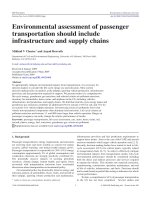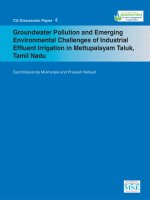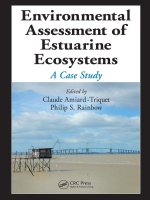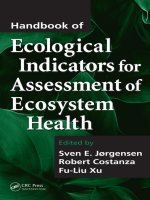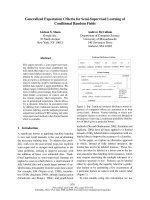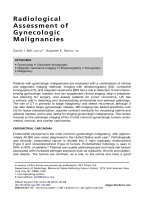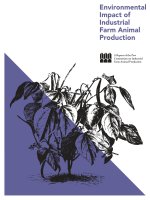CRITERIA FOR COMPREHENSIVE ENVIRONMENTAL ASSESSMENT OF INDUSTRIAL CLUSTERS ppt
Bạn đang xem bản rút gọn của tài liệu. Xem và tải ngay bản đầy đủ của tài liệu tại đây (1020.76 KB, 56 trang )
Central Pollution Control Board
Ministry of Environment and Forests
Website: www.cpcb.nic.in • e-mail:
DECEMBER 2009
Ecological Impact Assessment
Series: EIAS/4/2009-10
of
C R I T E R I A F O R C O m p R E h E n s I v E
EnvIROnmEnTAl AssEssmEnT
IndustrIal ClustersCriteria for
Comprehensive Environmental
Assessment of Industrial Clusters
Central Pollution Control Board
Ministry of Environment and Forests
Website: www.cpcb.nic.in • e-mail:
DECEMBER 2009
Ecological Impact Assessment
Series: EIAS/4/2009–2010
© Central Pollution Control Board, 2009
All rights reserved. No part of this publication may be reproduced in any form or by any means without
prior permission from Central Pollution Control Board
Published by
J S Kamyotra, Member Secretary, Central Pollution Control Board, Delhi – 110 032
at ENVIS Centre - 01
Printed in India by TERI Press, The Energy and Resources Institute, New Delhi
33
CONTENTS
Forward 5
Chapter 1: Introduction 7
Chapter 2: Quantifi cation of Environmental Characteristics 9
Need for quantifi cation 9
Methods developed for identifi cation and quantifi cation 11
General Structure of Environmental Indices 11
Descriptive Environmental Indices 12
Normative Indices 13
Main characteristics of an environmental index 14
Challenges faced 15
Chapter 3: Comprehensive Environmental Pollution Index 17
Proposed comprehensive environmental pollution index for industrial clusters 18
Scope of proposed CEPI 18
Framework 18
Scoring Methodology 19
Guidelines for Application of CEPI 22
Categorization of industrial clusters 27
Chapter 4: Summary and conclusions 29
References 31
Appendices
1 Group B: probable human carcinogens 32
2 Group C: known human carcinogens 34
3 List of 17 categories of highly polluting industries 37
4 List of the 54 red categories 38
5 Environmental standards 40
6 Exceedence factor calculation 49
7 Participants of the workshop 50
4
LIST OF TABLES
Table 1 Penalty values for combination of most critical pollutants - Factor A1 21
Table 2 Penalty values for combination of most critical pollutants - Factor B1 21
Table 3 Penalty values for combination of most critical pollutants - Factor C1 23
Table 4 Score for additional higher-risk elements - Factor D 23
Table 5 Problems and solutions in CEPI application 28
4
Foreword
Pollution load in air, water, and soil is not just an environmental challenge, but synergistically a
public health challenge as well. There is an urgent need to classify polluted industrial clusters based
on scientifi c criteria and design action plans accordingly.
Comprehensive Environmental Pollution Index (CEPI) is a rational number to characterize the
environmental quality at a given location following the algorithm of source, pathway and receptor.
Increasing value of CEPI indicates severe adverse effects on environment and also is an indication of
large percentage of population experiencing health hazards.
CEPI comprehensively captures various dimensions of pollution without loosing important
information embedded into it. The aim of the study is to prioritize industrial clusters in the order of
planning needs for interventions. CEPI therefore, forms the basis for comprehensive remedial action
plan for the identifi ed severely polluted/critically polluted industrial clusters.
The present CEPI is intended to act as an early warning tool, which is easy and quick to use. It can help
in categorizing the industrial clusters/areas in terms of priority. These industrial clusters/areas shall
be investigated to for defi ning the spatial boundaries as well as the extent of eco-geological damages.
The outcome shall be subjected to structured consultation with the stakeholders for determining
comparative effectiveness of alternative plans and policies. The effective implementation of the
remedial action plan will help in abatement of pollution and to restore the environmental quality of
these industrial clusters.
Evolving CEPI has been a comprehensive exercise of Central Pollution Control Board (CPCB)
involving Ministry of Environment and Forests (MoEF), Indian Institute of Technology (IIT), Delhi,
IIT Kanpur, IIT Kharagpur, IIT Roorkee, Delhi Technological University, TERI University, BITS
Pilani, National Environmental Engineering Research Institute, Public Health Foundation of India
and experts from various organizations, institutions, universities, industries and NGOs. Valuable
contribution from the participants from these organizations is thankfully acknowledged.
Special thanks are due to Shri J S Kamyotra, Member Secretary, CPCB, and Shri A K Vidyarthi,
Environmental Engineer, CPCB for their continuous efforts in evolving CEPI. Dedicated efforts in
conceptualizing, testing and fi ne tuning the CEPI methodology by Dr Arvind K Nema, Associate
Professor, IIT Delhi are thankfully acknowledged. Thanks are also due to Professor Mukesh Khare, Dr
B J Alappat, and research staff at IIT Delhi for their sincere efforts in giving feedback and analysing
the data and TERI for printing the script.
It is hoped that this report would be useful to all the concerned for improving environmental
quality.
Prof. S P Gautam
Chairman, CPCB
Central Pollution Control Board
(A Govt. of India Organisation)
Ministry of Environment & Forests
Phone: 22304948 / 22307233
‘Parivesh Bhawan’ C.B.D. cum Offi ce Complex, East Arjun Nagar, Delhi - 110 032
E
nvironmental pollution remains a serious issue in the developing world, affecting
the lives of billions of people, reducing their life expectancy, and damaging children’s
growth and development. The World Heath Organization (WHO) estimates that
25% of all deaths in the developing world can be directly attributed to environmental
factors. The problem of pollution, and its corresponding adverse ecological impacts
have been aggravated due to increasing industrial and other developmental activities. India,
among other developing nations of the world, is facing the challenge of industrial pollution at an
alarming rate. This has made the constant surveillance of environmental characteristics a necessary
task. There is an urgent need to identify critically polluted areas and identify their problematic
dimensions. Accordingly, measures have to be taken to make our process of industrial development
and economic growth more sustainable. The biggest hindrance in this task is the lack of tools to
identify the problematic areas and the lack of an objective criterion to rank these areas in order of
their needs for mitigation measures and, hence, the resources.
This has led to the realization of the need for an objective method so as to analyse the
environmental conditions of the identifi ed industrial clusters/areas. To accomplish this, it is required,
at the fi rst instance, to process the base level information and develop a robust methodology for
identifi cation and ranking of the
selected industrial clusters/areas
based on various dimensions of
pollution.
Critically polluted industrial
areas/clusters are not only
environmental challenges but they
are also public health challenges.
Indeed, only a fraction of national/
international efforts have been
made, so far, for remediation of such
critically polluted areas, despite their
signifi cant threat to environmental
and public health. The comprehensive
environmental pollution index
Chapter 1
Introduction
Criteria for Comprehensive Environmental Assessment of Industrial Clusters
8
(CEPI) helps in quantifying the environmental health of the critically polluted areas by synthesizing
available information on environmental status by using quantitative criteria.
For this purpose, various methods have been developed and evaluated in the past. However,
there still exist enormous challenges in quantifying the environmental characteristics of critically
polluted areas. A review on the environmental consequence estimation methods has been carried
out to identify the gaps in the existing methods in assessing hazards due to environmental release
of emissions in Chapter 2.
Chapter 3 underlines the development procedure of CEPI. This chapter describes an innovative
method of developing CEPI for relative ranking of industrial areas/clusters based on properties of
hazardous substances used, produced or stored; inventory of the substances; and environmental
conditions of the locations under investigation. Different decision-making criteria have been
incorporated in the development of CEPI.
Chapter 4 presents the summary and future roadmap.
9
NEED FOR QUANTIFICATION
A
nthropogenic activities are one of the major sources of environmental pollution. In
the recent past, the problem of pollution, and its adverse ecological impacts have
been aggravated
by an increase
in the scale of
residential, industrial, and
other developmental activities
including hydroelectric
power plant projects, mining,
and so on. This has led to a
realization that there is a need
to formulate an objective
method to quantify the
environmental conditions of
such polluted areas. Besides,
there has been a growing
concern about environmental
sustainability, which has
attracted the concerted efforts
of researchers from different
disciplines including natural sciences, social sciences, engineering, and the humanities. The ever-
increasing world population, coupled with the growing societal demands, have been triggering
rapid pace of industrialization, resource extraction, and intensive production. Unfortunately, such
swift industrialization and urbanization has caused negative environmental effects, damaging the
ecosystem. Resource depletion, greenhouse effect, global warming, acidifi cation, air pollution,
water pollution, soil pollution, and their impact on human health are some of the major negative
consequences. Broadly, these impacts may be categorized into two groups such as the following.
Impacts on sensitive environment
Impacts on humans
•
•
Chapter 2
Quantification of Environmental
Characteristics
Criteria for Comprehensive Environmental Assessment of Industrial Clusters
10
In both the cases, these impacts may be routed through surface and ground water, air, fi re, and
explosion or direct contact. Industrial releases to the environment can clearly have two types of
impacts.
Methods like ecological risk assessment and environmental impact assessment are being used
to determine the impact of developmental projects and other human activities in a region. Many
researchers have used the techniques of geographic information systems (GIS) in the same but
there is a critical need for adopting spatially explicit modelling approaches to handle the dynamics
imposed by heterogeneous environments. One of the reasons that the demand for integrated
environmental information has recently increased in many countries is because integrated
information is essentially used in evaluating the performance of environmentally sustainable
development.
Further, there have been various hazardous incidences in the past due to industrial pollution.
These catastrophic incidences have made the public aware of current environmental issues. This
awareness has brought worldwide concern for the environmental consequences of industrial
pollution and, hence, the development of methods for its evaluation. As a result, several methods
have been developed for the assessment of environmental consequences.
The aggregated measurement of environmental performance or sustainability, which is usually
in the form of a comprehensive environmental pollution index (CEPI), has evolved as a focus
in environmental systems analysis. CEPI offers decision-makers the condensed environmental
information for performance monitoring, policy progress evaluation, benchmarking comparisons,
and decision-making. CEPI reduces the number of indicators by aggregating them to make the
information easily accessible; otherwise it is very diffi cult to evaluate the environmental performance
Criteria for Comprehensive Environmental Assessment of Industrial Clusters
11
on the grounds of so many environmental indicators. CEPIs are very valuable as a vehicle for
providing environmental information in a clear and succinct manner. CEPIs are especially very
useful for environmental decision-making by policy-makers, although environmental experts may
have several means for analysing many indicators. However, decision-makers are much more likely
to rely on integrated information such as the CEPIs (Kang 2002).
METHODS DEVELOPED FOR IDENTIFICATION AND
QUALIFICATION
A large number of studies have, so far, been reported on the construction of the CEPI. They
deal with cases that range from a specifi c environmental theme to the whole economic–energy–
environmental system and from a single country/region to multiple countries/regions (Zhou,
Ang, and Poh et al. 2005). In order to assess environmental consequences, various methods have
been developed by researchers/academicians. Each method has its limitations, advantages, and
applicability for different scenarios. Broadly, two separate sets of tools exist, fi rst, the methods
for identifi cation and quantifi cation of abnormal situations, that is, environmental hazards; and,
second, the methods for quantifi cation of planned releases or emissions (the environmental
consequences include potential damage to both environment and humans).
Recent developments in this fi eld involve the development of indices for inherent environmental
safety and chemical process route selection based on Boolean mathematics. The use of fuzzy logic
theory in the development of inherent safety index enhances the effectiveness of the results.
Various methods are available for forming environmental impact indices. These indices are
of two major types, one, the indices based on the amount of waste produced and, second, indices
based on the relative environmental effects of different key parameters such as pollutant emissions,
land usage and energy consumption, as well as unquantifi able parameters like aesthetic value.
General structure of environmental indices
Figure 1 describes the general structure of environmental indices by showing the relation between
environmental data, indicators, and
indices.
The fi rst step, in construction
of an environmental index, consists
of the collection of data pertaining
to various environmental themes
as mentioned above. The second
step involves aggregation of the
data related to environmental
component indicators for example,
water, air, soil, and so on. Each
indicator is a mathematical function,
which has been defi ned as variables
characterizing the respective
environmental components. These
Criteria for Comprehensive Environmental Assessment of Industrial Clusters
12
indicators serve as arguments of a mathematical function that describes the overall state of the
environment by a single rational number, that is, the environmental index. Hence, indicators are
often also referred to as sub-indices. At each stage of this aggregation process, information is lost
on the one hand while simplicity and intelligibility of the environmental ‘message’ is gained on
the other. Obviously, there is no single ‘correct’ way of aggregating, for example, air pollution data
(nitrogen oxides, sulphur dioxide, carbon dioxide, and so on) to form an air quality indicator.
There is always a certain degree of arbitrariness inherent in the choice of an aggregation function.
It depends on the environmental component and the kind of variables to be described by the
indicator.
An overview of the most important environmental indices, which are used in the practice
of environmental monitoring, is given in the following section. There exist a variety of different
indices and the examples that refl ect the up to date developments.
Descriptive environmental indices
The construction of all descriptive indices follow a two-step procedure. In the fi rst step, suitable
indicators – representative for an environmental issue – are selected or created from the underlying
data. Subsequently, the set of these indicators is aggregated to an overall index number using an
appropriate aggregator function (Ahlheim 2005).
Figure 1 The relation between environmental data, indicators, and indices
Source Ahlheim (2005)
Criteria for Comprehensive Environmental Assessment of Industrial Clusters
13
Normative indices
The normative indices combine the measurement of certain indicator values with a normative
statement. One form of normative indices are the achievement indices that are designed to measure
and visualize the extent to which a specifi c environmental goal (that is, the normative statement)
has already been attained. Another form can be seen in the comparison of a state index with
a normative statement of sustainability. The German Environmental Index (DUX), developed
in 1999 for the specifi c purpose of conveying information about the effectiveness of national
environmental policy to the general public, is an example of normative index. The aim of the
set of indicators is to inform policy-makers and the public about spatial inequity with respect to
environmental (living) conditions in order to identify those regions within a country that should
be given high priority for environmental improvements.
The construction of these indicators is based on the relation of measured environmental data,
for example, ambient pollutant concentration in a certain region to a threshold value (that is, the
target) considered acceptable from a health-related point of view. As such, these set of indicators
are purely based on expert knowledge. The so-called ecological footprint (EF), as an example of a
Figure 2 The construction process of CEPI
Defining
environmental
system
Variables selection
and classification
Data collection and
processing
Performance
comparisons
Decision
making
Policy
making
Data aggregating
CEPI
Theoretical level
Operational level
Goal level
Criteria for Comprehensive Environmental Assessment of Industrial Clusters
14
sustainability index, represents a normative index in the sense that it allows the direct comparison
to a normative measure of sustainability.
Some popularly used tools for environmental quantifi cation are described as below.
Hazardous ranking system This has been adopted by the Environment Protection Agency,
United States (USEPA). The hazardous ranking system (HRS) is a numerically based screening
system to assess the relative potential of sites to pose a threat to human health or the environment.
The US EPA scores four pathways under the HRS, which includes groundwater, surface water,
soil exposure, and air migration.
Air quality index The AQI is calculated by using pollutant concentration data, a given table,
using the following equation (linear interpolation).
Where I
p
= the index for pollutant p; C
p
= the rounded concentration of pollutant p; BP
Hi
= the
breakpoint that is greater than or equal to C
p
; BP
Lo
= the breakpoint that is less than or equal to C
p
;
I
Hi
= the AQI value corresponding to BP
Hi
; I
Lo
= the AQI value corresponding to BP
Lo
.
MAIN CHARACTERISTICS OF AN ENVIRONMENTAL
INDEX
Such indices are typically informational tools used for communication between environmental
experts, politicians, and the public at large. To this end, environmental indices are presumed to
make complex and detailed information on the state of the environment simpler and more lucid.
They may serve as a means of resource allocation, of judging and comparing the quality of
different locations, of measuring the success of environmental policy or of informing the public
on the development of environmental quality in a country or in certain geographic regions.
This multipurpose character of environmental indices imply the well-known dilemma inherent
in this concept, that is, the
environmental index should
be easy to understand and
interpret for laymen and
the information it conveys
should not be trivial or too
superfi cial.
Their construction
implies a reduction of
complex, multidimensional
environmental specifi cs to a
single number, which goes
along with a considerable loss
of information as compared
to the original data set
underlying the respective
indices. The reason why one
•
•
I
p
= (C
p
– BP
Lo
) + I
Lo
I
Hi
– I
Lo
BP
HI
– BP
Lo
Criteria for Comprehensive Environmental Assessment of Industrial Clusters
15
is willing to accept this loss of information is
the hope that more people will be interested
in such a condensed informational tool
than in the complex data set on which it
is based. The intention to fi nd the middle
ground, between these two claims, has led
to constructions that are neither noticed by
the people nor are very instructive from a
scientifi c point of view (Ahlheim 2005).
CHALLENGES FACED
Lack of basic environmental monitoring
and hence the data, defi cient information
on environmental and public health effects
of pollutants, arbitrary selection of weights
assigned to environmental themes, and a
lack of rationale in the use of the index are
the major problems to be dealt with in the
process of creating an environmental index,
and its further application. There also lies
a major problem of loss of information. It
is necessary to strike a balance between the
simplicity of usage of the index, and its scientifi c correctness. The comparison of the index values
to classify critically polluted areas is also a debatable issue. One of the main experiences in research
(EQI), thus far, has been that the reductionist approach has failed to analyse adequately the complex,
multidisciplinary, and large-scale global phenomena. The EQIs currently in use are not organized
within any integrated framework. This implies that they do not yield information about linkages
between causes and effects nor cross-linkages between various causes and various effects.
A major problem in constructing the CEPI is the determination of an appropriate aggregating
method to combine multidimensional environmental variables into an overall index. Despite the
existence of large number of CEPIs, there is a lack of objective criteria for choosing an appropriate
aggregating method (Kang 2002). A meaningful environmental index has been defi ned as an index
for which the underlying ranking order is independent of the choice of the measurement units. It
has been described that the CEPI aggregated by the weighted geometric mean method is meaningful
when the environmental variables are strictly positive and when the ratio-scale is incomparable. It
has been observed that CEPIs by the weighted sum method are generally not meaningful.
If the environmental variables are normalized and become dimensionless before aggregating,
the CEPIs given by the weighted geometric mean and weighted sum methods are both meaningful
and the two methods become incomparable, though there will always be subjectivity in selecting
the contributing factors in the index.
The problem of choosing the response function is also to be handled. Even if there are a large
number of various environmental factors, usually we can identify many factors that have an impact
on the index. The impact of the other factors can be regarded as ‘ecological noise.’
Criteria for Comprehensive Environmental Assessment of Industrial Clusters
16
Loss of information, while aggregating sub-indices, is also a major problem that poses a
challenge to the authenticity of a comprehensive environmental index. If an aggregating method
would always result in few loss of information in contrast to other aggregating methods, it might
be regarded as a better aggregating method. If the aggregating method used is a perfect method,
there would be no loss of information.
The dilemma between comprehensibility and scientifi c profoundness is also not easy to resolve.
The computation of a pollution index is meant to be particularly simplifi ed by the use of selected
environmental quantities that are representative, that is, indicative, of some theme related to
pollution. However, no solution can be proposed to determine the relative importance of pollution
themes in an objective way.
17
T
he goal of this project is to prioritize critically polluted industrial clusters/areas based
on scientifi c criteria. For this purpose, base level information is needed so that a
robust methodology can be developed. In such a measure, various dimensions of
pollution are to be captured.
The index may then be used for quantifi cation of the environment, health,
determining the effectiveness, and comparing alternative plans and policies in order to help
environmental decision-makers.
The main objectives of the CEPI project are as follows.
To identify critically polluted industrial clusters/areas from the point of view of pollution and
taking concerted action and for being centrally monitored at the national level to improve the
current status of environmental components, for example, air and water quality data, public
complaints, ecological damage, and visual environmental conditions.
To facilitate the defi nition of critically polluted industrial clusters/areas based on the
environmental parameter index and prioritization of an economically feasible solution through
the formulation of an adequate action plan for environmental sustainability.
CEPI is a rational number to characterize the quality of the environment at a given location following
the algorithm of source, pathway, and receptor. As CEPI increases, an increasingly large percentage
of the population is likely to experience increasingly severe adverse health effects. As far as the
role of the environmental pollution index in identifying and assessing the environmental health
of critically polluted area is concerned, it is required to identify environmental aspects and create
an asset of core pollutants adopted for each industrial cluster, develop monitoring programme
for set of pollutants selected, develop the database for CEPI, and process it and develop CEPI for
industrial clusters.
The index being evaluated, developed, and used here is a holistic, integrated, systems-oriented
approach, which concentrates on the cause–effect interactions and feedback mechanisms among
different subsystems rather than focusing on each subsystem in isolation. This appears to be
promising as a conceptual tool for understanding and comparing environmental indices. The CEPI
developmental process involved a brain storming workshop conducted at IIT Delhi.
The workshop was inaugurated by Shri Jairam Ramesh, Honorable Minister of State
(Independent Charge), Environment and Forests, Government of India. Other dignitaries present
•
•
Chapter 3
Comprehensive Environmental
Pollution Index
Criteria for Comprehensive Environmental Assessment of Industrial Clusters
18
included Prof. S P Gautam,
Chairman, Central Pollution
Control Board (CPCB);
Shri J S Kamyotra, Member
Secretary, CPCB; Prof. S M
Ishtiaque, Deputy Director
(Administration), IIT Delhi;
and Dr K Srinath Reddy,
President, Public Health
Foundation of India (PHFI).
Prof Mukesh Khare and
Dr Arvind K Nema, IIT Delhi,
presented the methodology
and framework of the proposed
CEPI for industrial clusters.
Eight groups of experts were
formed for evaluating various
industrial clusters/area to gather a feedback on developed methodology and framework to quantify
CEPI. Each group contained four to fi ve members including experts from academia, research,
industry, NGOs, and regulatory agencies.
Four case studies of listed full out CPAs were given to each group, out of which case studies
of Angul Thalchar and Ankleshwar area were common to all eight groups. This was done to assess
and evaluate CEPI, and then to compare the score in order to evaluate the difference in CEPI score
by different groups. The rest of the case studies were different for different groups. The feedback
from the workshop was used to fi nalise the proposed CEPI.
Proposed comprehensive environmental pollution index for
industrial clusters
Scope of the proposed CEPI
The proposed CEPI is aimed at evaluating the areas primarily subjected to industrial
pollution.
CEPI is aimed at assessing the effect of pollution at the local level around industrial clusters.
The global environmental issues are not covered by the proposed CEPI.
CEPI does not refl ect the potential accidental release of pollutants in the area or in a nearby area.
Framework
A comprehensive CEPI to assess the industrial clusters/areas is a three-step process (as described
below).
STEP I The status of the area is assessed based on ground information. The framework proposed
is as follows.
Source
—
> Pathways
—
> Receptor
•
•
•
Criteria for Comprehensive Environmental Assessment of Industrial Clusters
19
STEP II Various environmental indicators are assessed and the status of environmental resources
such as land, vegetation, air, and water is investigated. Spatial and temporal data/information shall
be used for this purpose.
STEP III Structured consultation with the following.
Local stakeholders
Experts
Policy-makers
The present method of calculating CEPI is aimed to carry out preliminary screening of the
polluted industrial clusters/areas following Step I. The outcome may be used for formulating
immediate preventive and control actions.
The present CEPI is intended to act as an early warning tool, which is easy and quick to use. It
can help in categorizing the industrial clusters/areas in terms of priority.
It is to be noted that the data/information available with CPCB and concerned State Pollution
Control Boards (SPCBs)/PCCs for the industrial areas/clusters have been used in Step I.
Additional information shall be collected and used corresponding to Steps II and III as the
future course of action. These industrial clusters/areas shall be subjected to detailed environmental
investigations (Step II and III) for defi ning the spatial boundaries as well as the extent of eco-
geological damages. The outcome of Step II and III shall be used for preparing a comprehensive
remedial action plan.
Scoring methodology
The scoring system involves an algorithm that takes into account the basic selection criteria. This
approach is based on the basic hazard assessment logic that can be summarized as below.
Hazard = pollutant source, pathways, and receptor
Each of these essential links in the causal chain is represented by criteria that are included in the
scoring methodology.
CEPI is calculated separately for air, water, and land in selected industrial cluster/area.
The basic framework of the proposed CEPI – based on three factors namely pollutant, pathway,
and receptor – has been described below.
POLLUTANT (up to three most critical pollutants to be taken)
Factor #A1 – Presence of toxin
Group A – Toxins that are not assessed as acute or systemic = 1
Group B – Organics that are probable carcinogens (USEPA Class 2 and 3) or substances
with some systemic toxicity, for example, VOCs, PAHs, PCBs, PM
10
and PM
2.5
= 2 (refer
Appendix 1 for list of Group B pollutants)
Group C – Known carcinogens or chemicals with signifi cant systemic or organ system
toxicity, for example, vinyl chloride, benzene, lead, radionuclide, hexachromium, cadmium,
and organophosphate = 4 (refer Appendix 2 for list of Group C pollutants)
•
•
•
•
P
P
P
Criteria for Comprehensive Environmental Assessment of Industrial Clusters
20
Figure 3 CEPI calculation methodology
Estimated score A1
(Based on the data on
the presence of toxins)
Pollutant score A
=A1 A2´
Pathway score B
=B1+B2+B3
EPI=A+B+C+D
Receptor score C
=C1+C2+C3
Estimated score C1
(Based on potentially
affected population)
Estimated score A2
(Based on the scale of
industrial activities)
Estimated score C2
(Based on the level
of exposure)
Estimated score C3
(Based on the risk to
sensitive receptors)
Additional high risk
element D
(Based on the information
on pollution
control facilities)
Estimated score B1
(Based on the pollutant
concentration data)
Estimated score B2
(Based on the impact
on people)
Estimated score B3
(Based on the impact on
eco-geological features
Criteria for Comprehensive Environmental Assessment of Industrial Clusters
21
Factor #A2 – Scale of industrial activities
Large = 5 (if there are
> 10 R17* per 10 km
2
area or fraction OR
> 2 R17 + 10 R54** per 10 km
2
area or fraction OR
> 100 R54 per 10 km
2
area or fraction
*R17 are 17 category of highly polluting industries other than red category industries categorized by CPCB (list of
industries in Appendix 3)
** R54 are red category industries categorized by Central Pollution Control Board (list of industries in Appendix IV)
Moderate = 2.5 (if there are
2 to 10 R17 per 10 km
2
area or fraction OR
10-100 R54 10 km
2
area or fraction
Limited = 1 (else there is any industry within 10 km
2
area or fraction)
These two factors are taken as multiplicative and so the overall score for this element is as follows.
SCORE A = A1 × A2 (max score = 6 × 5 = 30)
PATHWAY
Factor #B1 – Ambient Pollutant Concentration (Standards of Pollutant Concentrations are
given in Appendix 5).
Critical = 6 (when exceedence factor* is more than 1.5)
High = 3 (when exceedence factor is between 1 and 1.5)
Moderate = 2 (when exceedence factor is between 0.5 and 1.0)
Low = 1 (when exceedence factor is < 0.5)
* The calculation procedure of exceedence factor is given in Appendix 6.
•
P
P
P
P
•
P
P
P
P
Table 1 Penalty values for combination of most critical pollutants Factor A1
S No. Pollutant 1 Pollutant 2 Pollutant 3 Penalty
1. C C C 2.0
2. C C B/A 1.75
3. C B B/A 1.5
4. B B B/A 1.0
Table 2 Penalty values for combination of most critical pollutants Factor B1
S No. Pollutant 1 Pollutant 2 Pollutant 3 Penalty
1. Critical Critical Critical/high/moderate 2.0
2. Critical High High/moderate 1.75
3. High High High 1.5
4. High High Moderate 1.0
Factor #B2 – Evidence* of adverse impact on people
No = 0 (when no reliable evidence is available)
Yes (when evidence of symptoms of exposure) = 3
Yes (when evidence of fatality or disease(s) leading to fatality (such as cancer) due to
exposure) = 6
•
P
P
P
Criteria for Comprehensive Environmental Assessment of Industrial Clusters
22
Factor #B3 – Reliable evidence of adverse impact on eco-geological features
No = 0 (when no reliable evidence is available)
Yes (when evidence of symptoms of exposure) = 3
Yes (when evidence of loss of fl ora/fauna/signifi cant damage to eco-geological features,
(irreparable loss/damage)) = 6
(* Reliable evidence is in form of media reports, hospital records, public interest litigations (PIL) and NGOs reporting,
academic research reports, published literature).
Overall score for this element is as follows.
SCORE B = B1 + B2 +B3 = (8 + 6 + 6) = 20
RECEPTOR
Factor #C1 – Number of people potentially affected within 2 km radius from the industrial
pollution source.
<1000 = 1
1000 to 10 000 = 1.5
10 000 to 100 000 = 3
> 100 000 = 5
Factor #C2 – Level of exposure
A surrogate number, which will represent the level of exposure (SNLF) is calculated using
percentage violation of ambient pollutant concentration, which is calculated as follows.
SNLF = (Number of samples exceeded/total number of samples) × (Exceedence factor)
– Low = 1 (SNLF = 0)
– Moderate = 1.5 (SNLF < 0.25)
– High = 2 (SNLF 0.25 - 0.5)
– Critical = 3 (SNLF > 0.5)
•
P
P
P
•
P
P
P
P
•
P
Table 3 Penalty values for combination of most critical pollutants Factor C1
S No. Pollutant 1 Pollutant 2 Pollutant 3 Penalty
1. Critical Critical Critical/high/moderate 2.0
2. Critical High High/moderate 1.75
3. High High High 1.5
4. High High Moderate 1.0
Factors C1 and C2 are taken as multiplicative.
Factor #C3 – Additional risk to sensitive receptors
No = 0
Yes (if > 500 sensitive people/ a sensitive historical/ archaeological/ religious/ national parks/
sanctuary/ecological habitat are within 2 km distance from source, additional risk) = 5
SCORE C = (C1 × C2) + C3 (max score = (5 × 5) + 5 = 30)
•
P
P
Criteria for Comprehensive Environmental Assessment of Industrial Clusters
23
ADDITIONAL HIGH-RISK ELEMENT
Factor #D – Additional high-risk element (inadequacy of pollution control measures for
large-scale, medium- and small-scale industries and also due to the unorganized sector). It is
cumulative of effl uent treatment plants (ETPs), common effl uent treatment plants (CETPs),
air pollution control devises (APCDs), and unorganized waste disposal. Maximum score = 20
If all the industries in the area have adequately designed/operated and maintained pollution
control facilities and also common facilities, such as CETP/EETP/CHWDF, this means that
they have adequate capacity and are having state-of-the-art technology = 0.
If all the large industries in the area have adequately designed/operated and maintained
pollution control facilities but small and medium industries are defaulting. Common
facilities, such as CETP/FETP/CHWDF, are having adequate in capacity or operation/
maintenance = 5.
If all the industries in the area have adequately designed/operated and maintained pollution
control facilities but the common facilities, such as CETP/FETP/CHWDF, are having
inadequate in capacity or operation/maintenance = 10.
If all the large industries in the area have adequately designed/operated and maintained
pollution control facilities but small- and medium-industries are defaulting. Common
facilities, such as CETP/FETP/CHWDF, are having inadequate in capacity or operation/
maintenance = 15.
Inadequate facilities of individual as well as common facilities, full penalty = 20.
•
P
P
P
P
P
Table 4 Score for additional high-risk element: Factor D
S No. Large- scale industries Small/medium -scale
industries
Common facilities for
pollution control
Score
1. Adequate Adequate Adequate 0
2. Adequate Inadequate Adequate 5
3. Adequate Adequate Inadequate 10
4. Adequate Inadequate Inadequate 15
5. Inadequate Inadequate Inadequate 20
Inadequate facilities > 10% units defi cient in terms of design/operation and maintenance of
pollution control in case of small- and medium-scale industries OR > 2% units defi ciency in
terms of design/operation and maintenance of pollution control in case of large-scale industries
or common facilities.
The status report (last two years) shall be used deciding the score for adequacy.
Calculation of the Sub-Index
After calculating A, B, C and D; calculate the sub index score as:
Sub-Index SCORE = (A + B + C + D) = (30 + 20 +30 +20) = 100
Sub index scores are to be calculated for each of the individual environmental components that is,
Air Environment, Surface Water Environment, and Soil & Ground Water Environment separately.
